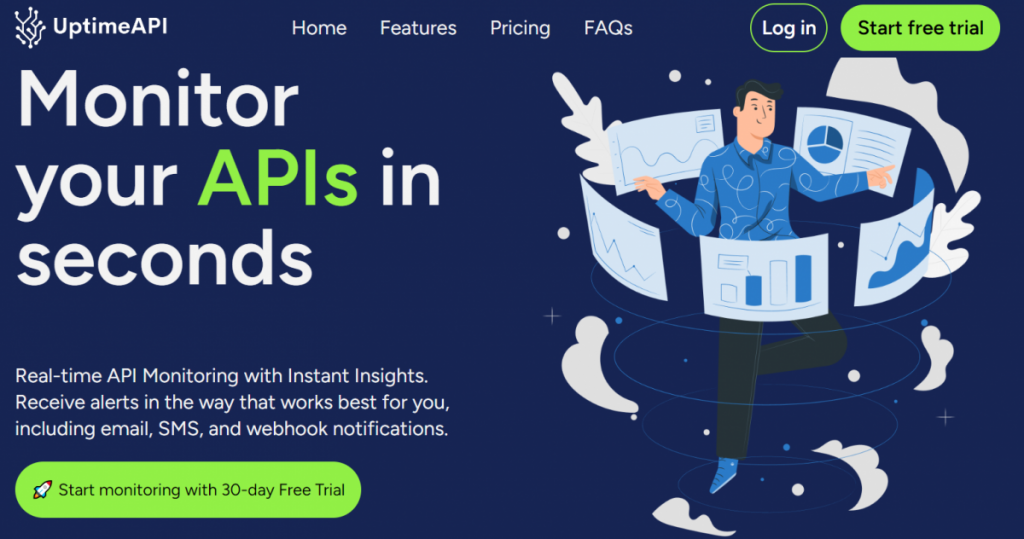As we step into 2024, the landscape of software development continues to evolve, and the role of APIs has become more crucial than ever. Ensuring the reliability, performance, and availability of APIs is a top priority for developers and businesses alike. UptimeAPI emerges as a key player in this domain, offering comprehensive solutions for monitoring and optimizing API usage. In this article, we will explore the current state of API usage in 2024, highlighting trends and best practices, and delve into the intricacies of the API response provided by UptimeAPI.
The Changing Face of API Usage in 2024

1. Proliferation of Microservices Architecture
Microservices architecture has become the backbone of many modern applications. In 2024, the adoption of microservices continues to rise, leading to an increased number of APIs within a single application. Developers are embracing microservices for their scalability, flexibility, and ease of maintenance.
2. Rise of Serverless Computing
Serverless computing is reshaping how developers deploy and manage applications. With serverless architectures, APIs are deployed as individual functions, allowing for more granular control and cost-effective scaling. In 2024, serverless API usage is on the ascent, offering improved resource utilization and reduced infrastructure overhead.
3. Focus on API Security and Governance
As the volume of API usage grows, so does the emphasis on security and governance. Developers and businesses are prioritizing API security measures to protect sensitive data and prevent unauthorized access. Governance frameworks ensure standardization and compliance across the diverse set of APIs employed in an ecosystem.
UptimeAPI: Elevating API Monitoring in 2024

Read More: Company profile APIUsage Cases
1. Real-Time Monitoring for Instant Visibility
UptimeAPI stands at the forefront of API monitoring solutions, providing real-time visibility into the health and performance of APIs. In 2024, where instantaneous insights are paramount, UptimeAPI ensures that developers can identify and address issues promptly, minimizing downtime and optimizing user experience.
2. Scalable Solutions for Microservices and Serverless Architectures
Acknowledging the prevalence of microservices and serverless architectures, UptimeAPI offers scalable solutions that align with these modern paradigms. Whether you have a multitude of microservices or individual serverless functions acting as APIs, UptimeAPI can efficiently monitor and provide actionable data.
3. Comprehensive Analytics for Governance and Optimization
UptimeAPI goes beyond basic monitoring by offering comprehensive analytics tools. In 2024, where governance and optimization are paramount, UptimeAPI’s analytics empower developers and businesses to track API usage trends, identify potential bottlenecks, and optimize performance for enhanced efficiency.
Decoding the UptimeAPI API Response
When an API endpoint is monitored by UptimeAPI, the API response provides detailed information about its health and performance. Let’s break down what a typical API response from UptimeAPI might look like:
json
Copy code
{
“status”: “success”,
“timestamp”: “2024-01-17T12:00:00Z”,
“endpoint”: “https://api.example.com”,
“response_time”: 50,
“error_rate”: 0.1
}
Key Components of the API Response:
- status: Indicates the status of the API request to UptimeAPI. “Success” signifies that the API endpoint is functioning correctly.
- timestamp: Provides the date and time of the API response.
- endpoint: Specifies the monitored API endpoint.
- response_time: Represents the time taken for the API endpoint to respond (in milliseconds).
- error_rate: Indicates the percentage of requests that resulted in errors.
The Future of API Usage: Continuous Innovation with UptimeAPI
As we navigate the ever-evolving landscape of software development, the future of API usage promises continuous innovation and growth. UptimeAPI stands as a reliable companion, facilitating this journey by providing developers with the tools they need to monitor, optimize, and secure their APIs effectively.
In 2024, where API usage is diverse and dynamic, UptimeAPI remains a key player, offering real-time monitoring, scalability for modern architectures, and comprehensive analytics. By integrating UptimeAPI into their workflows, developers can ensure that their APIs meet the demands of an ever-connected and ever-evolving digital landscape.
Conclusion
API usage in 2024 reflects the transformative trends of microservices, serverless architectures, and heightened focus on security and governance. UptimeAPI not only aligns with these trends but also contributes to the advancement of API monitoring and optimization.
As we move forward, the importance of reliable and performant APIs will only intensify. UptimeAPI, with its advanced monitoring capabilities and insightful API responses, positions itself as an indispensable tool for developers and businesses navigating the intricacies of modern API usage. Embrace the future of API development with UptimeAPI, and ensure your APIs are at the forefront of innovation and reliability in 2024 and beyond.
You

